Related Research Articles

A grape is a fruit, botanically a berry, of the deciduous woody vines of the flowering plant genus Vitis.

Vitis vinifera, the common grape vine, is a species of Vitis, native to the Mediterranean region, Central Europe, and southwestern Asia, from Morocco and Portugal north to southern Germany and east to northern Iran. There are currently between 5,000 and 10,000 varieties of Vitis vinifera grapes though only a few are of commercial significance for wine and table grape production.
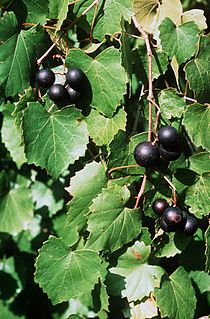
Vitis rotundifolia, or muscadine, is a grapevine species native to the southeastern and south-central United States. The growth range extends from Florida to New Jersey coast, and west to eastern Texas and Oklahoma. It has been extensively cultivated since the 16th century. The plants are well-adapted to their native warm and humid climate; they need fewer chilling hours than better known varieties, and thrive in summer heat.

Macabeo, also called Viura or Macabeu, is a white variety of wine grape.

Vermentino is a light-skinned wine grape variety, primarily found in Italian wine. It is widely planted in both in Sardinia and Liguria, to some extent in Corsica, in Piedmont under the name Favorita, and in increasing amounts in Languedoc-Roussillon. The leaves are dark green and pentagonal. The grapes are amber-yellow and hang in pyramidal bunches. The vines are often grown on slopes facing the sea where they can benefit from the additional reflected light. The Vitis International Variety Catalogue now gives Italy as its origin.

Vitis (grapevines) is a genus of 79 accepted species of vining plants in the flowering plant family Vitaceae. The genus is made up of species predominantly from the Northern hemisphere. It is economically important as the source of grapes, both for direct consumption of the fruit and for fermentation to produce wine. The study and cultivation of grapevines is called viticulture.
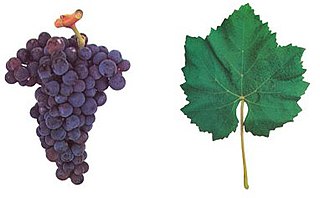
Castelão, in Portugal also known as Periquita and João de Santarém, is a red wine grape found primarily in the south coastal regions but is grown all over Portugal and is sometimes used in Port wine production. The name is derived from the Portuguese term for parakeet.
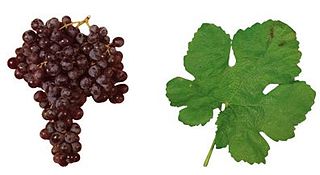
Tinta Negra Mole is a red Portuguese wine grape commonly used in the production of Madeira. It is the most widely planted variety on the Madeira islands and is considered the industry's "workhorse grape".
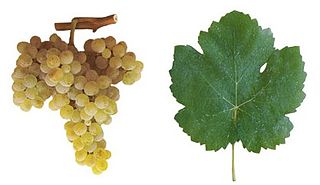
Bical is a white Portuguese wine grape planted primarily in the Bairrada region. It can produce high acid wines and is often used in sparkling wine production.
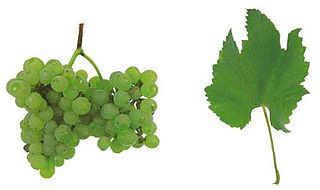
Fernão Pires is a white Portuguese wine grape grown throughout Portugal, especially in the Tejo and Bairrada, where it is also known as "Maria Gomes". This variety is known to produce wines with a spicy aromatic character, though often with delicate exotic fruity notes. Generally not expected to be a long-living wine, this wine is best drunk in its infancy or matured for up to 2 or 3 years. Outside of Portugal there are some significant plantings in South Africa.

Baga is a red Portuguese wine grape variety planted primarily in the Bairrada DOC. As a varietal, Baga produces tannic wines with high acidity.

Frappato di Vittoria or Frappato is a red Italian wine grape variety planted primarily in Sicily. As a varietal, Frappato produces light bodied wines with a distinct grapey aroma. It is most commonly seen as a component of Sicily's only DOCG wine, Cerasuolo di Vittoria, which consists of 30-50% Frappato and 50-70% Nero d'Avola.
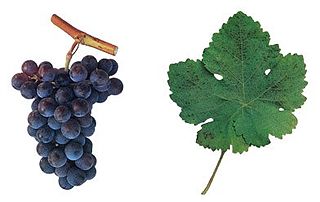
Ramisco is a red Portuguese wine grape variety that is planted primarily in the Colares DOC. As a varietal, Ramisco produces very tannic and astringent wines.
Brustiano bianco is a white French wine grape variety from the island of Corsica. The grape was thought to be extinct until DNA testing of vines on nearby Sardinia led to the discovery that the Licronaxu bianco and its color mutation grapevine Licronaxu nero were in fact Brustiano bianco. This discovery has allowed for the grape to be reintroduce to Corsica where it is often blended with Vermentino, Biancu Gentile and Scimiscià.

The propagation of grapevines is an important consideration in commercial viticulture and winemaking. Grapevines, most of which belong to the Vitis vinifera family, produce one crop of fruit each growing season with a limited life span for individual vines. While some centenarian old vine examples of grape varieties exist, most grapevines are between the ages of 10 and 30 years. As vineyard owners seek to replant their vines, a number of techniques are available which may include planting a new cutting that has been selected by either clonal or mass (massal) selection. Vines can also be propagated by grafting a new plant vine upon existing rootstock or by layering one of the canes of an existing vine into the ground next to the vine and severing the connection when the new vine develops its own root system.
Allorhizobium vitis is a plant pathogen that infects grapevines. The species is best known for causing a tumor known as crown gall disease. One of the virulent strains, A. vitis S4, is responsible both for crown gall on grapevines and for inducing a hypersensitive response in other plant species. Grapevines that have been affected by crown gall disease produce fewer grapes than unaffected plants. Though not all strains of A. vitis are tumorigenic, most strains can damage plant hosts.
Nocera is a dark black Italian grape variety producing deeply colored, high acidity wines. It originates from the north eastern region of Sicily and is now also grown in Calabria. It is an allowed component of five DOC wines as well as 15 IGT wines. It has good vigor but poor disease resistance.

Hebén is a very rare white grape variety grown for wine and table grapes in Spain. It is an ancient variety found to have originated as a table grape in North Africa as Gibi. It is the parent variety of a large number of grapes grown in the Iberian Peninsula and the wider Mediterranean. It has paired with Alfrocheiro to produce the rare Portuguese varieties Trincadeira das pratas, Tinta grossa, Castelão branco, and Malvasia fina, as well as the Spanish Allarén. With Muscat of Alexandria it has produced Moscatel nunes/Nuno gomes in Portugal and Moscatel de Angüés in Spain. In Spain, it has a parent relationship with some very widely grown varieties: Airén, Cayetana, Viura, Xarel·lo, and Pedro Ximénez. In total, around 60 offspring varieties have been identified. Its sparse bunches are an attribute that can be seen some in children varieties such as Pedro Ximénez and Xarello. It produces solely female flowers, unlike the majority of self-pollinating vinifera varieties grown for wine today.
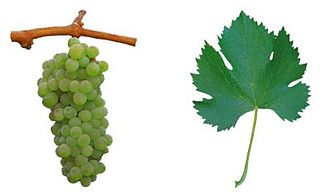
Antão Vaz is a native Portuguese white wine grape variety. Genetic testing has shown it to be a cross of the white Cayetana blanca and the almost unknown red João Domingos, which is thought to be extinct in its native Portugal. It is grown primarily in the Alentejo region, with additional plantings around Lisbon and in the Península de Setúbal. It is vigorous and productive, and requires a hot climate. The thick skins on these large loosely packed grapes enable them to withstand high heat and dehydration. It produces complex, light yellow wines with citrus and tropical aromas. Depending on the time of harvest, the wines can range from very acidic to ripe and alcoholic.
Taferielt is an indigenous Moroccan wine, table, and raisin grape. It produces medium to very long clusters of dense, ellipsoid/obovoid, blue-black grapes. It is a parent, along with Jaén blanco, of the Moroccan variety Blanc de Rhafsaï.
References
- 1 2 Kym Anderson (5 June 2016). "Brustiano Faux". Wein-Plus.eu. Retrieved 2017-09-28.
- ↑ "BRUSTIANO FAUX". Vitis International Variety Catalogue VIVC. Julius Kühn-Institut - Federal Research Centre for Cultivated Plants (JKI), Institute for Grapevine Breeding - Geilweilerhof (ZR). August 2017. Retrieved 2017-09-28.
- ↑ LACOMBE, T.; BOURSIQUOT, J.M.; LAUCOU, V.; Di VECCHI-STARAZ, M.; PEROS, J.P.; THIS, P. (2013). "Large-scale parentage analysis in an extended set of grapevine cultivars (Vitis vinifera L.)". Theoretical and Applied Genetics. 126: 401–414. doi:10.1007/s00122-012-1988-2. PMID 23015217.